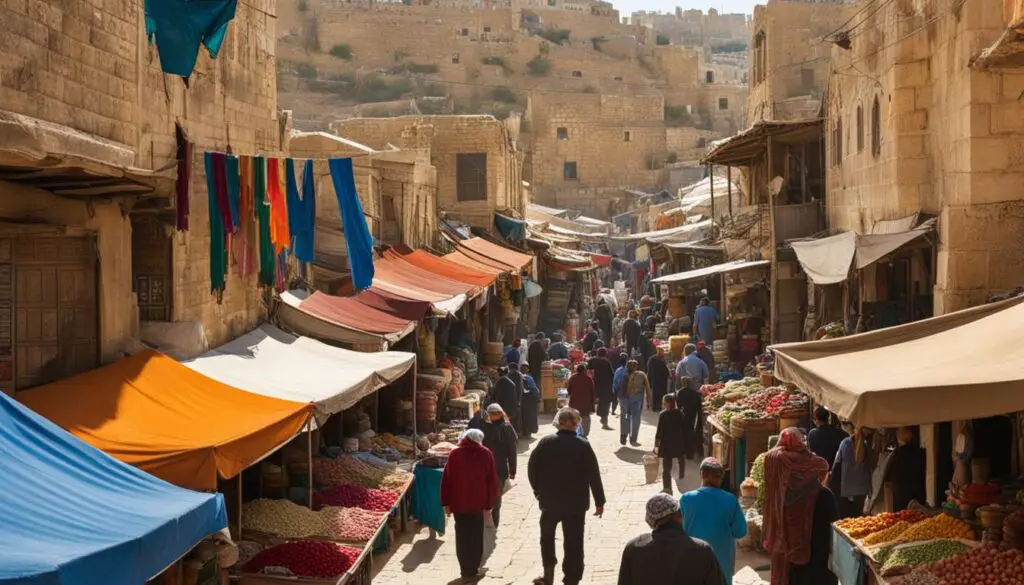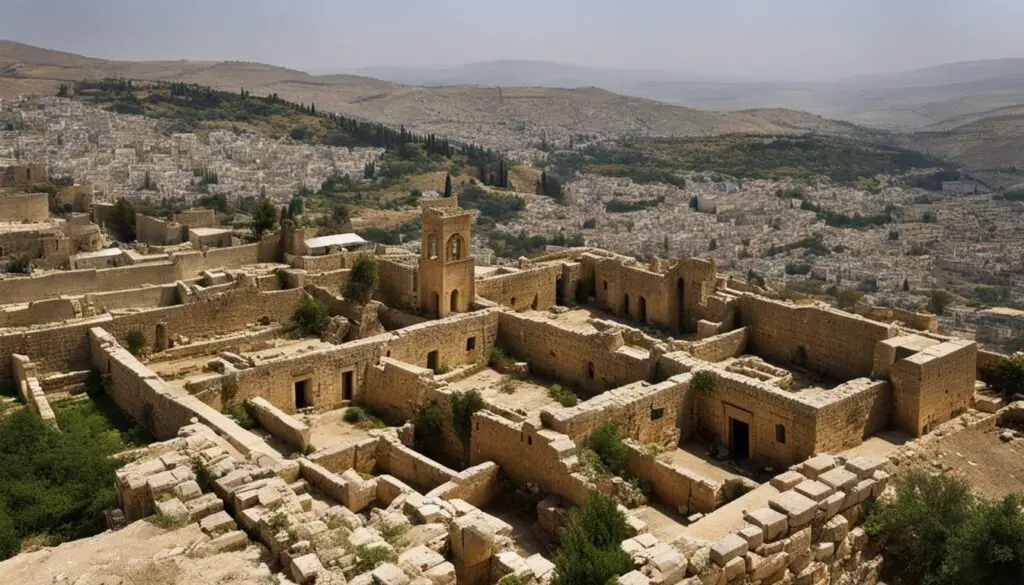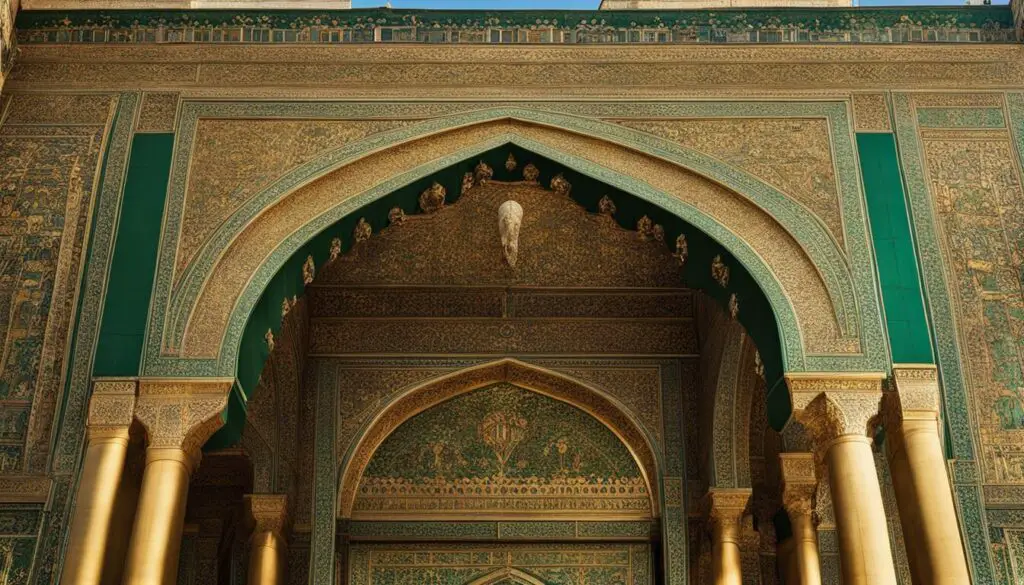Hebron, a historical city located in the West Bank, is a captivating destination that offers visitors a glimpse into the past and a chance to experience its timeless charm. With its rich history and vibrant cultural heritage, Hebron has been a significant site for thousands of years, deeply rooted in biblical importance.
In biblical times, Hebron played a pivotal role in numerous significant events. Notable biblical figures, such as Abraham, who is considered the father of the Hebrew people, are linked to this city. Abraham settled in Hebron and purchased a burial plot known as the Cave of Machpelah or the Tomb of the Patriarchs, where he, Sarah, Isaac, Rebecca, Jacob, and Leah are believed to have been laid to rest.
Today, Hebron remains a city of great cultural and historical importance. Visitors can explore religious sites, including the Tomb of the Patriarchs, which attracts pilgrims and tourists from around the world. The city’s ancient ruins and archaeological sites offer a glimpse into its rich past, allowing visitors to walk in the footsteps of ancient civilizations.
Uncovering the beauty of Hebron’s ancient ruins and exploring its religious sites is a truly enchanting experience. The city’s cultural heritage is evident in its historical attractions, traditional handicrafts, and thriving Hebron Glass industry. Hebron is a treasure trove of history and spirituality that leaves a lasting impression on all who venture to discover its hidden treasures.
Key Takeaways:
- Hebron is a historical city in the West Bank, with a rich history and cultural heritage.
- Biblical figures like Abraham are associated with Hebron, and the city holds great biblical significance.
- Hebron’s ancient ruins and archaeological sites provide insights into its past.
- Major biblical events, such as David’s anointing as king and Absalom’s rebellion, occurred in Hebron.
- Today, Hebron is home to religious sites, ancient ruins, and a thriving cultural heritage.
Biblical Significance of Hebron
Hebron holds immense biblical importance. It is associated with many notable figures, including Abraham, who is considered the father of the Hebrew people. According to the Bible, Abraham settled in Hebron and is said to have purchased a burial plot in the city, known as the Cave of Machpelah or the Tomb of the Patriarchs. This sacred site is believed to be the final resting place of Abraham, Sarah, Isaac, Rebecca, Jacob, and Leah. The biblical events linked to Hebron have shaped its history and continue to be revered today.
Hebron’s connection to Abraham makes it a significant city in religious and historical contexts. The biblical account portrays Abraham as a key figure in the origins of the Jewish people and the establishment of their relationship with God. His presence in Hebron solidifies the city’s role as a significant place in biblical history and reinforces its importance in the eyes of believers.
“And the field of Ephron, which was in Machpelah, which was before Mamre, the field, and the cave which was therein, and all the trees that were in the field, that were in all the borders round about, were made sure unto Abraham for a possession in the presence of the children of Heth, before all that went in at the gate of his city” – Genesis 23:17-18
The Tomb of the Patriarchs
The Tomb of the Patriarchs stands as a testament to the biblical significance of Hebron. It is a site of pilgrimage and reverence for Jews, Muslims, and Christians alike. The grand architecture of the tomb and its historical importance attract visitors from around the world, seeking to pay homage to the biblical patriarchs and matriarchs buried within its hallowed halls.
In addition to Abraham, other notable biblical figures such as Isaac, Jacob, and their wives are believed to be buried in the tomb. This sacred space serves as a symbol of unity and shared history for people of different faiths, highlighting the enduring legacy of Hebron’s biblical importance.
| Notable Biblical Figures | Connection to Hebron |
|---|---|
| Abraham | Purchased the Cave of Machpelah |
| Sarah | Buried in the Cave of Machpelah |
| Isaac | Buried in the Cave of Machpelah |
| Rebecca | Buried in the Cave of Machpelah |
| Jacob | Buried in the Cave of Machpelah |
| Leah | Buried in the Cave of Machpelah |
Hebron’s biblical significance reverberates throughout its history and continues to draw visitors who seek to connect with the roots of their faith. From the ancient times of Abraham to the present day, Hebron remains a city intertwined with the narratives of religious belief and cultural heritage.
Hebron in Biblical Times
In biblical times, Hebron was a bustling city that held great significance as a religious center and a place of pilgrimage. Archaeological discoveries have unearthed ancient ruins and artifacts that provide insights into the city’s past. The remains of structures and findings from excavations offer glimpses into the daily life and architectural marvels of Hebron during biblical times.
Hebron served as a hub for religious activities, attracting worshippers from far and wide. It was a city of cultural diversity and historical importance. The Table below showcases some of the key archaeological discoveries that shed light on Hebron’s biblical past.
| Discovery | Description |
|---|---|
| The Tel Rumeida archaeological site | Revealed remnants of Canaanite and Israelite periods, including walls, buildings, and pottery. |
| The Hebron Glass industry | Ancient glass production techniques were discovered, showcasing the city’s craftsmanship in biblical times. |
| The ruins of the ancient city | Provided insights into the urban layout and architectural wonders of Hebron during biblical times. |
These archaeological discoveries present a vivid picture of Hebron’s rich history and the vibrant civilization that thrived within its walls.
Major Biblical Events in Hebron
Hebron, a city of immense historical and biblical significance, has been the setting for several major biblical events that have shaped its history and impacted the world.
The Anointing of David as King
“Then the men of Judah came to Hebron, and there they anointed David king over the tribe of Judah” – 2 Samuel 2:4
Hebron played a vital role in the establishment of the Davidic dynasty and the history of Israel. It was in Hebron that David, the renowned biblical figure, was anointed as the king of Israel. This event marked a significant turning point in the nation’s history and solidified Hebron’s place as a significant city.
The Rebellion of Absalom
“And the conspiracy grew strong, and the people with Absalom kept increasing” – 2 Samuel 15:12
Another major biblical event that unfolded in Hebron was the rebellion of Absalom against his father, King David. Absalom’s revolt had a profound impact on Hebron and the wider kingdom of Israel. It led to a period of turmoil and upheaval, with significant consequences for the region’s political and religious landscape.
These major biblical events, the anointing of David as king and the rebellion of Absalom, continue to be celebrated and remembered in Hebron today. They have become an integral part of the city’s cultural and historical fabric, defining its identity and significance.
| Event | Significance |
|---|---|
| Anointing of David as King | Establishment of the Davidic dynasty and the history of Israel |
| Rebellion of Absalom | Period of turmoil and political upheaval |
Hebron Today
Hebron, with its rich cultural heritage, is home to numerous religious sites and ancient ruins that continue to fascinate visitors today. As one of the oldest continuously inhabited cities in the world, Hebron offers a unique glimpse into the past and a chance to explore its captivating history.
One of the main attractions in Hebron is the Tomb of the Patriarchs, a religious site of immense significance for Jews, Muslims, and Christians. Believed to be the final resting place of biblical figures such as Abraham and Sarah, the tomb serves as a place of pilgrimage and worship. Visitors can admire the stunning architectural grandeur of the site and witness the spiritual devotion of believers from different faiths.
Aside from its religious sites, Hebron also boasts a wealth of ancient ruins that showcase the city’s historical importance. Exploring the Tel Rumeida archaeological site, visitors can uncover remnants of ancient structures and gain insights into Canaanite and Israelite periods. These archaeological discoveries offer glimpses into the daily life and architectural marvels of Hebron during biblical times.
| Religious Sites | Ancient Ruins |
|---|---|
| The Tomb of the Patriarchs | Tel Rumeida archaeological site |
| Ibrahimi Mosque | Remnants of ancient structures |
| Abrahamic Mosque | Insights into Canaanite and Israelite periods |
With its cultural heritage, religious sites, and ancient ruins, Hebron continues to be a city of great historical and archaeological significance. Visitors can immerse themselves in the captivating history of Hebron, exploring its streets, markets, and landmarks that have stood the test of time.

Exploring the Cultural Heritage of Hebron
Hebron’s cultural heritage is a testament to its historical attractions and religious sites. Visitors to this remarkable city can delve into its diverse cultural tapestry, experiencing the rich blend of traditions and influences that have shaped Hebron over the centuries. From the vibrant markets of the Old City to the sacred sites of worship, Hebron offers a captivating journey through its cultural heritage.
One of the highlights of Hebron’s cultural heritage is the Old City, a UNESCO World Heritage site. Its narrow alleys and traditional houses transport visitors back in time, allowing them to feel the pulse of the city’s vibrant past. The bustling marketplaces, filled with colorful textiles, spices, and handicrafts, provide a glimpse into Hebron’s thriving trade history.
The religious sites in Hebron are an integral part of its cultural heritage. The city is home to mosques, churches, and synagogues, each representing a different facet of Hebron’s religious diversity. The most prominent religious site is the Tomb of the Patriarchs, revered by Jews, Muslims, and Christians alike. Its architectural magnificence and spiritual significance make it a must-visit destination for those seeking to explore Hebron’s cultural heritage.
“Hebron’s cultural heritage is a tapestry woven from diverse traditions, offering visitors a unique opportunity to immerse themselves in the richness of its history and traditions.” – Cultural Heritage Center
Table: Religions in Hebron
| Religion | Significant Religious Sites |
|---|---|
| Judaism | Tomb of the Patriarchs |
| Islam | Ibrahimi Mosque |
| Christianity | Abrahamic Mosque |
The cultural heritage of Hebron extends beyond its religious sites. The city is renowned for its traditional crafts, including the famous Hebron Glass industry. Visitors can witness the skilled artisans at work, producing exquisite glassware using traditional techniques passed down through generations. These crafts are a testament to Hebron’s cultural resilience and its commitment to preserving its heritage.
Exploring Hebron’s cultural heritage is a journey of discovery and appreciation. The city’s historical attractions and religious sites offer a glimpse into its fascinating past, while the rich traditions and crafts showcase the vibrancy of its present. It’s an experience not to be missed for those seeking to immerse themselves in the allure of Hebron’s enchanting cultural heritage.
Uncovering the Beauty of Hebron’s Ancient Ruins
Hebron is a city steeped in history, and its ancient ruins offer a captivating glimpse into the past. The archaeological sites in Hebron bear witness to the rich cultural heritage and historical significance of this remarkable city. From the Tel Rumeida archaeological site to the remnants of ancient structures, visitors can explore the traces of ancient civilizations and walk in the footsteps of those who came before.
The Tel Rumeida archaeological site is a treasure trove of historical artifacts and remains. Here, you can uncover the remnants of Canaanite and Israelite periods, including walls, buildings, and pottery. These discoveries provide valuable insights into the daily lives and architectural marvels of Hebron during biblical times. As you wander through the ancient ruins, you can’t help but be awed by the monumental achievements of those who built and inhabited this once-thriving city.
“The ancient ruins of Hebron tell a story of a city that has stood the test of time. Exploring these remnants allows us to connect with the past and gain a deeper understanding of the historical significance of Hebron.” – Dr. Sarah Rosenberg, Archaeologist
Hebron’s ancient ruins not only showcase the architectural prowess of ancient civilizations but also highlight the historical significance of the city. They serve as a tangible link to the biblical events that unfolded here, shaping the course of history. From the reign of King David to the rebellion of Absalom, Hebron’s ancient ruins provide a backdrop to these major biblical events, offering a unique perspective on their impact and legacy.
| Ancient Ruin | Significance |
|---|---|
| Cave of Machpelah | Believed to be the burial place of biblical figures, including Abraham and Sarah |
| Tel Rumeida | Offers insights into the Canaanite and Israelite periods |
| Remnants of ancient structures | Showcases the architectural marvels of Hebron during biblical times |
Hebron’s ancient ruins are a testament to the city’s enduring legacy and a fascinating destination for history enthusiasts and curious travelers alike. As you explore these archaeological sites, you can’t help but be transported back in time, marveling at the ingenuity and resilience of those who lived and thrived in the ancient city of Hebron.

The Charm of Hebron’s Religious Sites
Hebron is a city steeped in religious significance, with its religious sites holding a special charm for visitors. One of the most prominent sites is the Tomb of the Patriarchs, which stands as a testament to the city’s rich biblical history. This magnificent architectural marvel has stood for centuries and serves as a place of pilgrimage and prayer for Jews, Muslims, and Christians alike. The spiritual significance of the tomb, believed to be the final resting place of Abraham and other biblical figures, draws believers from around the world.
Aside from the Tomb of the Patriarchs, Hebron is also home to other notable religious sites. The Ibrahimi Mosque, also known as the Cave of Machpelah, is a sacred space where Muslims come to honor their ancestors and offer prayers. The Abrahamic Mosque, located within the same complex, is a significant place of worship for Jews who revere the site as the burial place of their biblical forefathers and mothers. These religious sites showcase the diverse faiths and the coexistence of different religious communities within the walls of Hebron.
Visiting these religious sites in Hebron is more than just admiring their architectural beauty; it is a spiritual journey that connects visitors with the ancient traditions and beliefs that have shaped the city’s cultural heritage. The serene atmosphere and historical significance of these sites provide a unique opportunity for reflection, contemplation, and appreciation of the spiritual legacy that Hebron continues to embody to this day.

Table: Religious Sites in Hebron
| Religious Site | Spiritual Significance |
|---|---|
| Tomb of the Patriarchs | Believed to be the final resting place of Abraham and other biblical figures, revered by Jews, Muslims, and Christians. |
| Ibrahimi Mosque | Sacred space for Muslims, believed to be the burial place of their ancestors and offering a space for prayer. |
| Abrahamic Mosque | Significant place of worship for Jews, associated with the burial site of their biblical forefathers and mothers. |
Exploring these religious sites in Hebron provides a glimpse into the city’s captivating history and its role as a center for religious devotion. Whether you are seeking spiritual solace, cultural enlightenment, or a deeper understanding of the city’s heritage, the religious sites of Hebron offer a truly enchanting experience that is sure to leave a lasting impression.
Conclusion
In conclusion, Hebron is a historical gem that offers a unique blend of cultural heritage and biblical significance. This fascinating city, located in the West Bank, is deeply rooted in biblical history and holds immense importance for believers of various faiths.
Hebron is associated with notable biblical figures, including Abraham, who is considered the father of the Hebrew people. The city’s biblical events, such as Abraham’s settlement and the anointing of David as king, have shaped its history and continue to be revered.
In biblical times, Hebron was a thriving city, known for its religious center and its role as a place of pilgrimage. Today, visitors can explore the ancient ruins and archaeological sites that offer glimpses into the city’s rich past and immerse themselves in its captivating history.
From the religious sites like the Tomb of the Patriarchs, which is a place of worship for believers of different faiths, to the cultural heritage evident in its traditional houses and marketplaces, Hebron is a destination that leaves a lasting impression. Discover Hebron for yourself and experience the allure of this enchanting city.
FAQ
What is the significance of Hebron?
Hebron is a city with a rich history and a vibrant cultural heritage. It holds immense biblical importance and is associated with notable figures like Abraham.
What biblical events are linked to Hebron?
Hebron was the setting for several significant biblical events, such as the anointing of David as king and the rebellion of Absalom against King David.
What can visitors see in Hebron today?
Visitors to Hebron can explore religious sites like the Tomb of the Patriarchs, as well as ancient ruins and archaeological sites that offer insights into the city’s past.
Are there religious sites in Hebron?
Yes, Hebron is home to various religious sites, including mosques, churches, and synagogues, representing the city’s diverse religious history.
What is the cultural heritage of Hebron?
Hebron’s cultural heritage is evident in its historical attractions, traditional handicrafts, and vibrant marketplaces, showcasing the city’s unique charm.
Can visitors explore ancient ruins in Hebron?
Yes, Hebron is home to a wealth of ancient ruins and archaeological sites that offer a glimpse into the city’s historical significance and ancient civilizations.
What is the most famous religious site in Hebron?
The Tomb of the Patriarchs is the most famous religious site in Hebron, attracting believers from different faiths for worship and pilgrimage.







